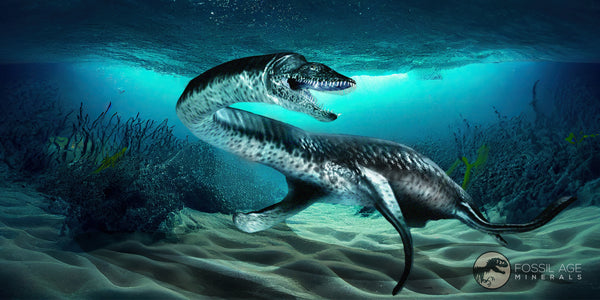4.4" Plesiosaur Fossil Vertebra Cretaceous Dinosaur Era Ozan FM Fannin County Texas
Location: Fannin County, Ozan Formation, Texas
Weight: 1 Pound 1.1 Ounces (With Medal Stand)
Dimensions: 6.1 Inches Long, 3.8 Inches Wide, 2 Inches Thick (With Metal Stand)
Vertebra Dimensions: 4.4 Inches Long, 3.8 Inches Wide, 1.7 Inches Thick
Comes with a Free Custom Metal Stand.
The item pictured is the one you will receive.
This is a genuine fossil.
Plesiosaurs were a group of marine reptiles that lived during the Mesozoic Era, from around 203 to 66 million years ago. They were characterized by their long necks, small heads, and paddle-like limbs. Fossil remains of plesiosaurs have been found in various parts of the world, including North America. In Fannin County, Texas, specifically within the Ozan Formation, plesiosaur fossils have been discovered.
The Ozan Formation in Texas is known for its Late Cretaceous deposits, which date back to around 95 million years ago. The formation consists of marine sediments that were deposited in a shallow sea that covered parts of present-day Texas during the Late Cretaceous period. Plesiosaur fossils found in the Ozan Formation provide valuable insights into the diversity and ecology of marine reptiles during this time.
The discovery of plesiosaur fossils in Fannin County, within the Ozan Formation, contributes to our understanding of the paleobiology and paleoecology of these ancient marine reptiles. By studying these fossils, researchers can reconstruct the anatomy and behavior of plesiosaurs and gain insights into their evolutionary history.
Overall, the presence of plesiosaur fossils in Fannin County, Texas, within the Ozan Formation highlights the rich paleontological heritage of the region and underscores the importance of continued research and exploration to uncover more about the prehistoric life that once inhabited these areas.
938 different specimens have been found by paleontologists

Please be aware of the nature of fossils:
Being buried under the ground for millions of years under tons of pressure tends to be rough. No fossil comes out of the ground whole and perfect. Most fossils have undergone some restoration, while others are altered by man simply to enhance their presentation in different ways. The workers in United States do a very professional job, of unearthing and preserving these natural treasures, however, commonly natural cracks are visible on the surface. These are part of the natural beauty of the fossil and are not considered defects.




















